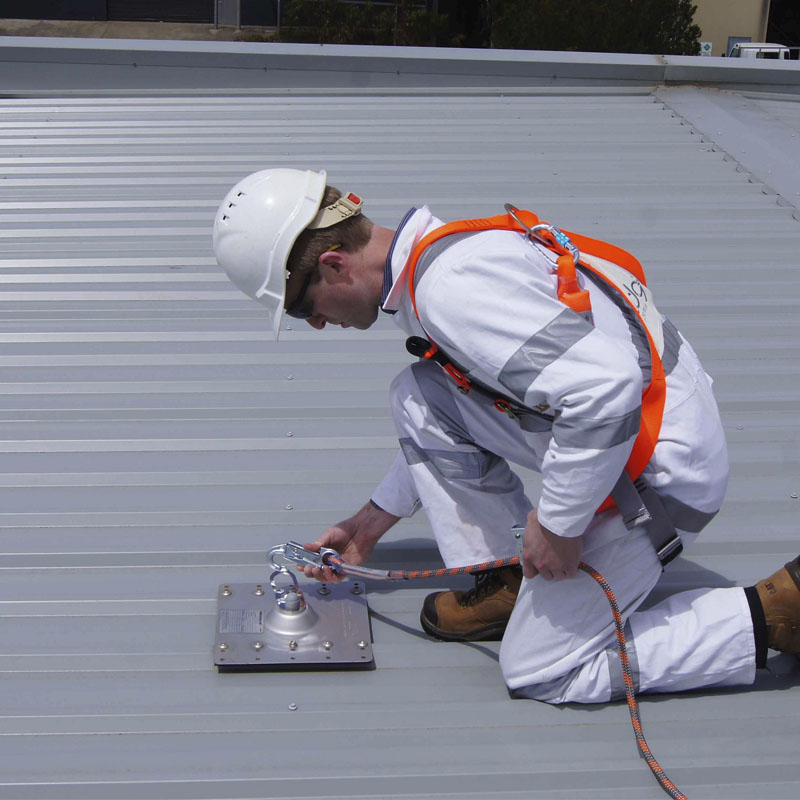Roof anchors are an impressive piece of height safety equipment. The reliability and high-strength qualities of roof anchor points makes them a necessary piece of safety equipment for construction and maintenance work conducted at heights.
Anchor Points Construction: What Are Anchor Points Made of?
Working at heights is necessary for many different tasks and can take place on a variety of surfaces. It makes sense then that one type of roof anchor point won’t work for all these scenarios, so there is a variety of anchor point products and systems available on the market to suit each individual uses. Each one is designed with the work type in mind and constructed using the most suitable materials for the job. Let’s take a look at what those materials are!
Roof anchor products from top vendors, like Austral Height Safety’s supplier Sayfa, have all been constructed from reliable materials, such as:
- Profiled stainless steel: Used for components like anchor base plates and swivel eyes. The profiling process allows for great accuracy during manufacturing, so each hole and contour will be exactly what is required to ensure efficiency and durability.
- Powder coated aluminium: Popular for the pivot arms. The powder coating offers impressive abrasion resistance, so there will be less corrosion and flaking.
- High tensile extruded aluminium: Appropriate for parts like deck clamps. Despite this metal being fairly lightweight, it’s still impressively strong. Aluminium is also a good option for use in cold environments.
- 316 Stainless steel: Strong enough for concrete mount anchors and an excellent option for surfaces that get hot, since it offers heat resistance. It also doesn’t corrode easily.
You can see, apart from their strength, these materials are able to endure many weather conditions, which is particularly important as roof anchors are typically installed outdoors. Longevity is also extremely important, especially for permanent installations. You can have peace of mind that even after months or years, your roof anchor point will still perform to best of its abilities thanks to its quality construction.
The weight allowance of the anchor point will depend on the type of roof anchor point you use, but their design and materials still make them practical to use. For example, temporary anchor points can weigh around 4kg up to 8kg without their fixings. This makes them sturdy, yet manageable and portable for the installation process.
A Note on Accessories
Not only does the 3sixty and explora 141 surface anchor point itself that determine its safety and efficiency, but it must also be held in place securely. Here we are referring to the anchor fixings. The type of surface an anchor is mounted to will determine this, such as self-drilling Tek screws for fixing the anchor on a metal surface or a type 14 Tek screw for timber fixing.
4 Features that Show Your Anchor Point can be Trusted
It’s clear only the best materials are used in anchor points from trusted brands like Sayfa. It’s also important to look at the following when you’re comparing different anchor products:
- Warranty: A warranty is proof of a vendor’s trust in its own product. So, even if you only plan on using a roof anchor point for a short while you need a long-term warranty on the gear. Quality components such as the ones from Sayfa have cover for up to 10 years, as long as proper maintenance is completed. This will require annual inspections and frequent checks, depending on the usage.
- Labels: Control is vital in an industry where the work and gear can mean life or death to workers. According to Australian and New Zealand standards, an anchor point must have details on display, such as when it was installed, who the installer was and also information about inspections. You’ll find this written on labels and tags on the unit.
- Compliance: Sourcing from quality manufacturers means your anchor points are made to be compliant with the country’s OHS codes.
- Load limits: Each anchor point, based on design, certification and its testing, will have a working load limit. This shows you how to ensure safe usage by simply not overloading it.
Final Thoughts
There are so many safety precautions that you should put into place before stepping foot on a rooftop. Accidents can happen quickly, but many injuries can be avoided. Knowing the ins and outs of your safety equipment is a wise first step. Call a height safety expert such as Austral to assist you.
Have any more questions? Our experts are happy to answer and assist with your project and decision making. Contact Austral Height Safety: admin@australsafety.com.au or 03 9462 3350.
